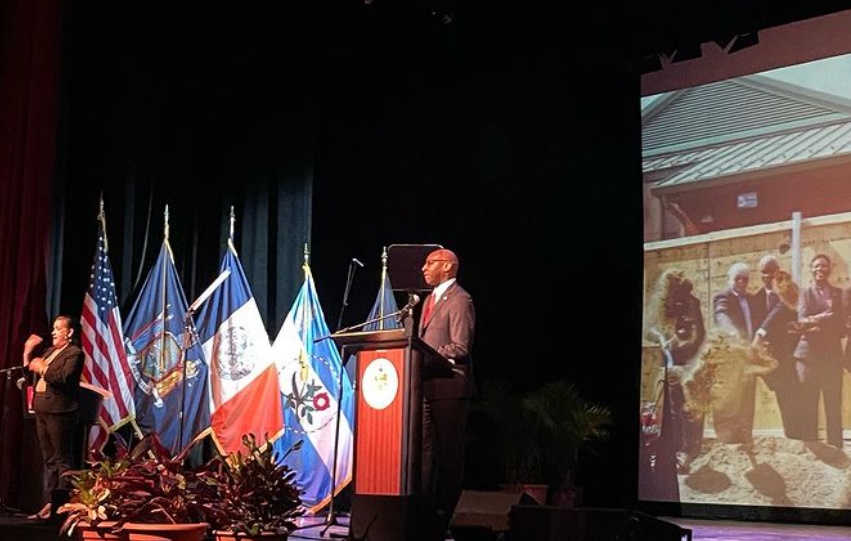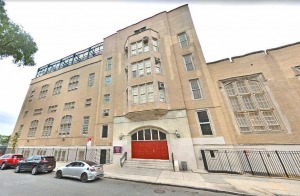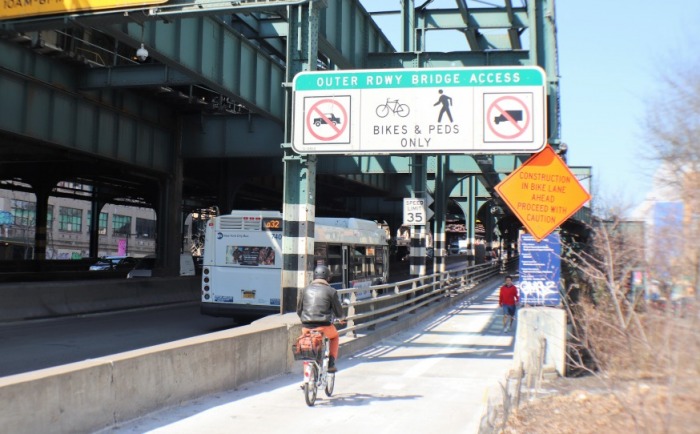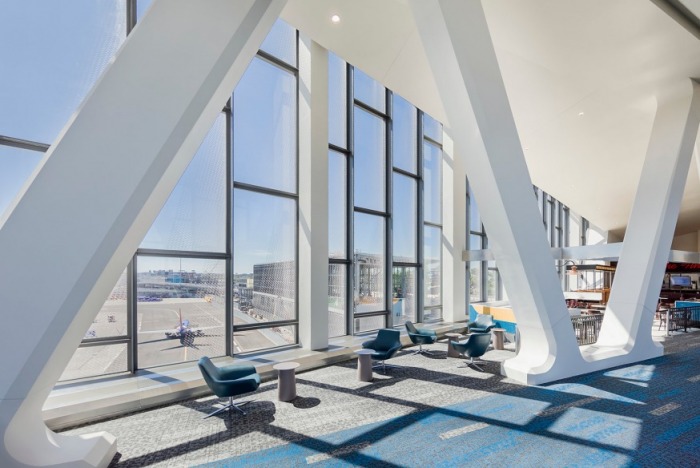
Queens BP Richards during his State of the Borough address (Photo: Instagram @queensbprichards)
June 6, 2022 By Michael Dorgan
Queens Borough President Donovan Richards delivered his State of the Borough address Friday where he outlined the borough’s accomplishments during his first 19 months in office and his plans to help Queens recover from the pandemic.
The event took place at the LaGuardia Performing Arts Center, located at 31-10 Thomson Ave., in Long Island City. Donovan’s speech was preceded by remarks from Mayor Eric Adams, City Council Speaker Adrienne Adams, state Attorney General Letitia James, and state Secretary of State Robert Rodriguez.
Richards covered a wide range of topics in his speech including health care and covid recovery, hate crimes and public safety, sustainability, transportation, economic development, civic engagement and budgetary investments.
He praised the borough for its response to COVID-19, where 86 percent of residents have been fully vaccinated against the virus– with 1.9 million residents having gotten their first two shots. The percentage is higher than any other borough in the city.
Looking to the future, he announced the creation of a borough-wide Hate Crimes Task Force to bolster public safety and a new initiative called Queens Forward aimed at tackling the root causes of crime.
Richards outlined plans to improve public transportation and clean energy. He also announced a number of budgetary allocations and plans to boost economic development in the wake of the pandemic.
“The State of our Borough is bruised, but not beaten,” Richards said. “Dented, but not defeated. From the ashes, Queens is rising faster and flying higher than anyone thought was possible just a few years ago.”
It was Richards’ second State of the Borough address since he took office in December 2020. However, it was his first time delivering the address in-person since the event was held virtually last year due to the pandemic.
He said he wants to build a better and fairer Queens as the borough emerges from the damage wrought by the COVID-19 pandemic.
One of the ways he aims to achieve this is by streamlining the city’s response to the pandemic through the creation of new “NYC Office of COVID Recovery.” The new office, which Richards proposed in January, would centrally manage the city’s overall response to COVID-19 and Richards said he is currently working with city council to get the plan approved.
Nevertheless, he said that Queens combatted the pandemic head-on, underscored by the 300,000 COVID vaccinations administered at Citi Field. Citi Field was the largest vaccination site in the city, he said.
Richards said more healthcare investment is needed, particularly in communities of color such as in Far Rockaway. He said NYC Health + Hospitals recently committed to building a new facility in the neighborhood while ground will be broken on a new labor and delivery unit there in the coming weeks.
The Queens Borough President’s Office, Richards said, has allocated nearly $19 million in capital dollars to health care facilities during his time in office—including $7.5 million for Elmhurst Hospital and $5.5 million for Queens Hospital.
Richards said that people’s health and wellbeing is also affected by crime and called for violence interruption programs – such as cure violence — to be expanded across Queens.
“Efforts like these are exactly how to combat crime effectively,” Richards said.
He also touted the construction of a $104 million NYPD stationhouse in Rosedale, which is expected to be completed by 2024 and reduce police response times in southeast Queens.
However, Richards said that more needs to be done to tackle the root causes of crime – which will be the main objective of the Queens Forward initiative.
Richards did not reveal details of the initiative, although he said Queens Forward will see capital investments being made in food security, education, economic development, violence prevention, open space, health care, affordable housing and resiliency.
Richards also called for the better treatment of inmates at Rikers Island, saying the facility is “the living, breathing personification of a system designed to fail communities of color. The new Jim Crow.”
He proposed creating a detainee advocacy program for inmates whereby they could testify in court about their efforts to better themselves while incarcerated. For instance, some inmates partake in self-help programs and educational courses while in prison. he said.
Richards said that he wants to see the Rikers jail facility shut down, and the island turned into a clean energy hub.
The transformation would be driven by Operation Urban Sustainability, a clean energy organization established in the spring. The organization, which is tasked with informing the Queens Borough President’s Office on ways to make Queens more sustainable, is comprised of environmentalists, clean energy leaders and transit advocates.
In his State of the Borough speech, Richards also celebrated the upcoming Champlain Hudson Power Express, a renewable energy project that will send hydropower from Canada to western Queens.

Richmond Hill High School
He also said that his office has allocated more than $500,000 to fund hydroponic farms at Richmond Hill High School, Math Science Research and Technology High School in Cambria Heights and P.S. 223 in Jamaica. Hydroponic farms are used to grow plants in an indoor environment.
Richards also called for funding from President Biden’s Infrastructure Bill to be used to replace aging sewer and water utilities across Queens, saying it would prevent flooding and ensure families have clean water to drink.
“Our children deserve to inherit a healthy borough once our time here is done,” Richards said. “That’s what I want for my son and all our kids, and I will do everything in my power to make Queens a global clean energy leader.”
Richards said that lowering greenhouse emissions was important in mapping out the borough’s transportation future and called on the Port Authority to establish a ferry service to LaGuardia Airport.
In his State of the Borough speech, Richards pledged to work with Governor Hochul and the MTA to establish the Interborough Express which would see an existing 14-mile freight line — running from Jackson Heights to Sunset Park — converted into a commuter railway.
He said the project would connect thousands of families on either side of the border to new economic opportunities, all while dramatically cutting commute times.
Richards used his address to celebrate traffic safety, including a $3 million investment he made toward enhancing pedestrian and cyclist safety on the Queensboro Bridge. His office also provided $1 million for improvements along Northern Boulevard in Western Queens.

Richards allocated $3 million toward enhancing pedestrian and cyclist safety on the Queensboro Bridge, pictured. (Photo by Michael Dorgan, Queens Post)
Richards also drew attention to the success of the 34th Avenue Open Street in Jackson Heights and wants to see the initiative extended throughout the borough.
“I want Open Streets in every corner of this borough, from Whitestone to Woodhaven to Jamaica, and we are fighting to make that a reality for families across Queens,” Richards said.
In terms of economic development, Richards said he worked to make sure JetBlue kept its headquarters in Long Island City instead of relocating to Florida.
Additionally, he celebrated the $8 billion redevelopment of LaGuardia Airport into a state-of-the-art facility and said that the $850 million in contracts were issued for Queens-based small businesses.
He also noted that small businesses were hit hard during the pandemic, but more than 750 business owners were able to tap into funding via the Queens Small Business Grant Program to help them navigate the economic crisis. The average grant size was $18,500, he said.

LaGuardia Terminal B, (LaGuardia Gateway Partners)
“Our small businesses help give our neighborhoods their identities, and they deserve a city that acts to protect them,” Richards said.
Richards also highlighted the return of the Bartlett Dairy — and its 200 union jobs — to Southeast Queens and the establishment of the Downtown Jamaica Improvement Council tasked with spurring economic growth in the area.
Overall, Richards said that the borough’s unemployment rate currently stands at 5.5 percent, down from 12.1 percent when he took office in December 2020.
On civic engagement, Richards lauded the diversity of Queens saying that of the 2.4 million residents, there are nearly 200 countries represented and more than 350 languages spoken.
He said that the borough’s 14 community boards have become more diverse with this year’s class being made up of 94 first-timers, 39 percent of whom are Black or Latin, 21 percent are parents of school kids, 20 percent are immigrants and 14 percent are Asian American.
“Making our 14 boards look, sound and feel like their communities is a commitment that is iron clad in my office.” Richards said.
Richards used his address to announce the launch a new initiative called Borough Hall on Your Block, where his office will travel to a different section of Queens for a week to engage with residents.
He also said he delivered on his promise to create an Immigrant Welcome Center at Queens Borough Hall, which has already served more than 400 residents since opening last summer.
Elsewhere Richards said he gave the green light to the approval of over 1,200 units of affordable housing across the borough. He called on the city to dramatically increase investment in creating affordable housing in Queens, noting that Queens receives 13 percent of the City’s affordable housing budget.
The borough president also highlighted the reopening of the NYC Department of Veterans Services’ satellite office at Queens Borough Hall. He said he is also supporting legislative efforts to create a Veteran-Owned Business city contracting system.
Lastly, In terms of capital funding, Richards said that his office has allocated more than $130 million to projects across the borough including more than $22 million for schools, nearly $20 million for Queens cultural organizations, $16 million each for libraries and parks and $10 million for CUNY campuses.
“Queens takes a back seat to no one,” Richards said.
“From Flushing to Forest Hills, Jamaica to Jackson Heights, Ridgewood to Rockaway, Corona to College Point and Queensbridge to Queens Village, we’re building a stronger, fairer Queens for all our families.”
“And there is no limit to what we can achieve when we work together.”
One Comment

Despite fellow Democrats in charge of City Hall, Albany and Washington, he has failed to secure any real funding under his watch for a number of transportation projects being championed by different community associations, transit advocacy groups or transportation agencies; The wish list includes: (1) Port Authority Cross Harbor Freight Tunnel -$10 billion; (2) new version of the La Guardia Air Train – $2 billion; (3) reopening of the LIRR Elmhurst Queens Station closed in 1978 – $40 million, (4) A free transfer between the NYC Economic Development Corporation Private Ferry Operators program and NYC Transit bus or subway systems – $ millions?, (5), Phase Two Woodhaven Blvd. Queens Select Bus Service – $258 million; (6) Light Rail between Jamaica and Long Island City on the old Lower Montauk LIRR branch – $2.2 billion; (7) Restoration of LIRR service on the old Rockaway Queens branch – $4 to 8 billion; (8) A new Main Street Flushing Queens Intermodal Bus Terminal – $100 million; (9) reopening the Woodhaven Blvd. Queens Atlantic Branch LIRR Station closed in 1982 – $40 million; (10) NYC Department of Economic Development Brooklyn-Queens Waterfront Street Car Connector – $2.7 billion; and (11) Brooklyn/Queens Interborough Express – some number under $10 billion according to MTA Chairman Janno Lieber just to name a few.
(Larry Penner is a transportation advocate, historian and writer who previously worked for the Federal Transit Administration Region 2 New York Office. This included the development, review, approval and oversight for billions in capital projects and programs for the MTA, NYC Transit, NYCDOT along with 30 other transit agencies in NY & NJ).